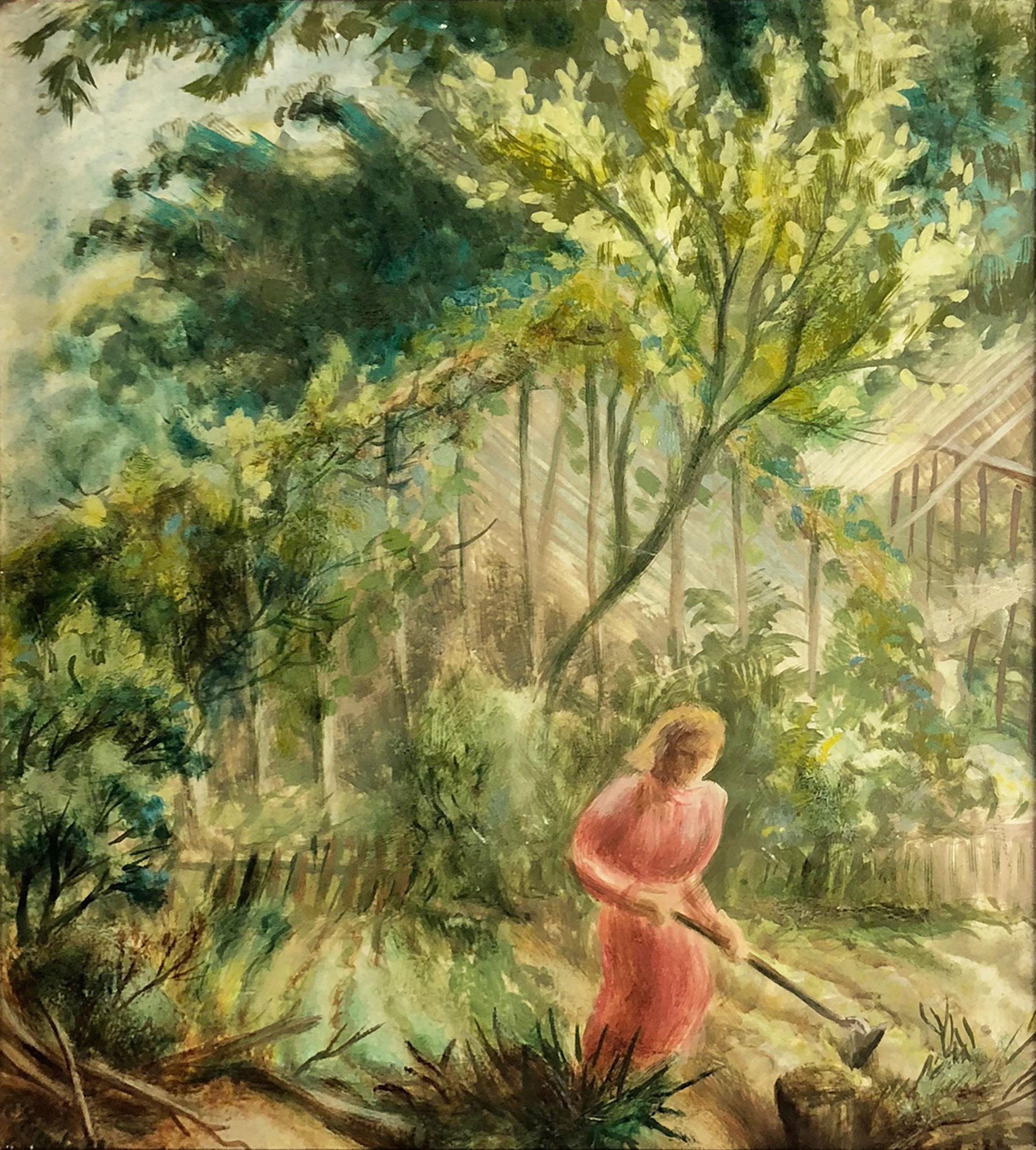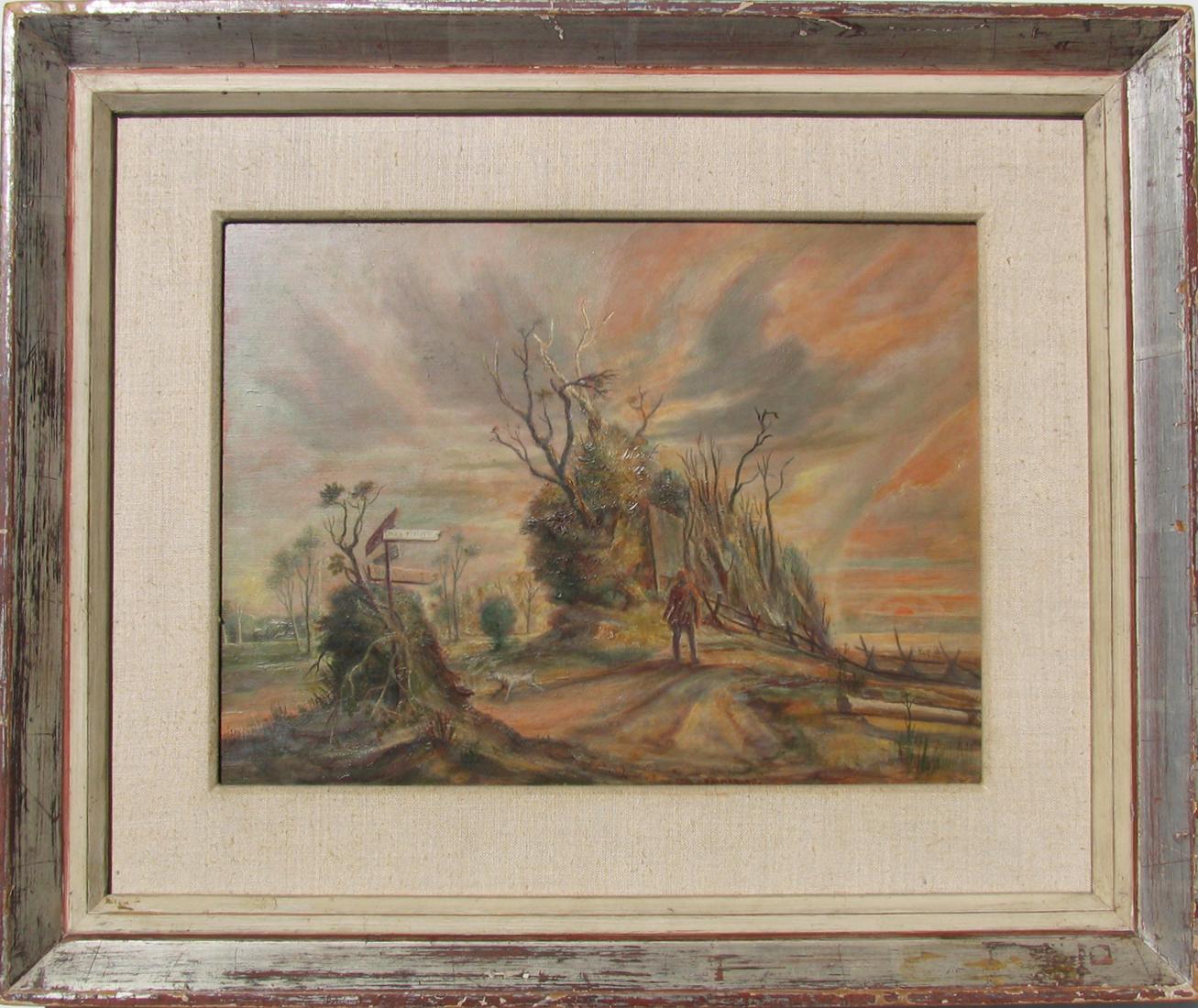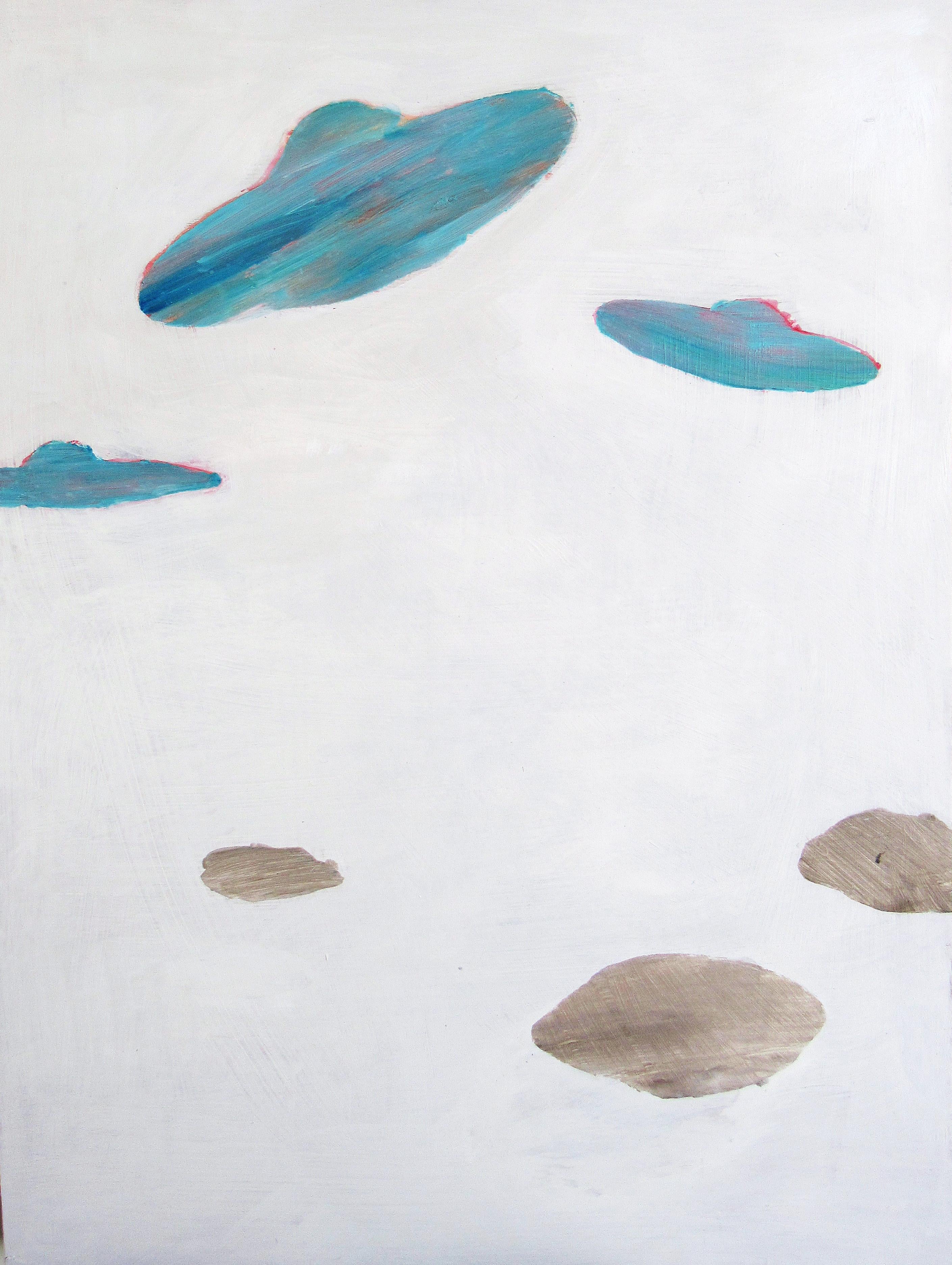Items Similar to Bird in Cage
Want more images or videos?
Request additional images or videos from the seller
1 of 7
John AthertonBird in Cageabout 1940
about 1940
About the Item
Gouache on board, 20 x 24 in.
Signed (at lower right): Atherton
Painted about 1940
RECORDED: Art News (May 11, 1940), illus. [clipping citation]
EXHIBITED: The Art Institute of Chicago, 1940, The International Watercolor Exhibition, no. 156, illus. on cover as Bird in Cage
EX COLL.: the artist; to private collection, as gift; by descent, until 2000
Born in Brainerd, Minnesota, John Atherton was an accomplished painter and illustrator whose fanciful, and highly original, compositions made him a significant figure in the American Surrealist movement (sometimes referred to as “Magic Realism”) of the 1930s and ’40s. After serving in the Navy during World War I, he began his career on the West Coast, studying at the College of the Pacific, in Stockton, California, and the California School of Fine Arts, in San Francisco. A $500 first prize at the annual exhibition of the Bohemian Club, in 1929, financed his move to New York, and he ultimately settled in Ridgefield, Connecticut. Much of Atherton’s early success came as an illustrator, and, in addition to his advertisement designs for General Motors and Shell Oil, his work graced the covers of such popular publications as Fortune and The Saturday Evening Post. Throughout the 1940s, Atherton was an active exhibitor at most of the major art institutions, including The Art Institute of Chicago; the Pennsylvania Academy of the Fine Arts, Philadelphia; The Corcoran Gallery of Art, Washington, D. C.; the Carnegie Institute, Pittsburgh; the Whitney Museum of American Art, New York; and the National Academy of Design, New York. He was also involved in a number of important exhibitions extolling Surrealism in America, including Dorothy C. Miller’s and Alfred H. Barr’s American Realists and Magic Realists at The Museum of Modern Art, New York, in 1943.
Atherton was represented by the Julien Levy Gallery, New York, a driving force behind the Surrealist movement in this country. The great modernist interest in dreams and the subconscious arrived in the United States from Europe in the early 1930s, but it was not until the end of the decade that the radical movement found wide acceptance here. The influential migration to America of such Surrealist luminaries as André Breton, Salvador Dali, Max Ernst, and Yves Tanguy began at the onset of World War II in 1939, approximately the same period Atherton painted the present picture.To even the most casual viewer, Bird in Cage seems fraught with symbolism. The large bird awkwardly trapped in an ornate cage is a hauntingly enigmatic image whose meaning we are instantly tempted to dissect. In Renaissance painting the caged bird was among the most popular iconographic symbols of female purity, but it was usually a domesticated bird. By confining what is clearly a wild water fowl of some sort, the artist may be referring to the human race’s often negative impact on the natural environment. When coupled with the desolation of the encroaching fog (or snow) bank, one might think of the devastating connotations associated with World War II. Importantly, however, while critics and admirers noted the intellectualism of Atherton’s paintings, the artist himself argued his compositions were ruled primarily by emotion. He once explained:
If my pictures are thought intellectual, so be it, but I believe they are so only in that when an emotion is responsible for certain results the intervening processes which go to make the emotion felt may be intellectual ones. In the end the painting must be felt, not analyzed (Dorothy C. Miller and Alfred H. Barr, Jr., eds., American Realists and Magic Realists, exhib. cat. [New York: The Museum of Modern Art, 1943], p. 26).
With this in mind, it may suffice to conclude that Atherton juxtaposed such odd and disconcerting images simply to convey the feeling of profound anxiety, isolation, and uncertainty brought on by the Depression and World War II. The closed-in house, clean, impersonal lines, and stark lighting seem to heighten the tension and uneasiness. True to his intentions, the meaning of Atherton’s works may always prove elusive, but the underlying emotion never fails to strike a chord with the viewer. Bird in Cage also exhibits Atherton’s impeccable sense of composition, which he honed during his many commissions for magazine covers. By employing a variety of horizontals, verticals, and diagonals he has created a carefully controlled and ordered scene. This enables him to express a great deal in a single, simple image, one which manages to convey intimacy, breadth, and depth at the same time.
Atherton was an avid fisherman and member of the Anglers Club of New York. He died at the age of fifty-two while on a salmon-fishing trip in New Brunswick, Canada. Atherton’s work is represented in numerous public collections, including The Metropolitan Museum of Art, New York; the Whitney Museum of American Art, New York; The Museum of Modern Art, New York; The Art Institute of Chicago; the Pennsylvania Academy of the Fine Arts, Philadelphia; and the Wadsworth Atheneum, Hartford, Connecticut
- Creator:John Atherton (1899 - 1972, American)
- Creation Year:about 1940
- Dimensions:Height: 27.25 in (69.22 cm)Width: 32.5 in (82.55 cm)
- Medium:
- Movement & Style:
- Period:
- Condition:
- Gallery Location:New York, NY
- Reference Number:
About the Seller
5.0
Recognized Seller
These prestigious sellers are industry leaders and represent the highest echelon for item quality and design.
Established in 1952
1stDibs seller since 2010
32 sales on 1stDibs
Typical response time: 10 hours
Associations
Art Dealers Association of America
- ShippingRetrieving quote...Ships From: New York, NY
- Return PolicyThis item cannot be returned.
More From This SellerView All
- San Pedro HarborBy Paul SampleLocated in New York, NYIt is infrequent, to say the least, that a diagnosis of tuberculosis proves fortuitous, but that was the event, in 1921, that set Paul Starrett Sample on the road to becoming a professional artist. (The best source for an overview of Sample’s life and oeuvre remains Paul Sample: Painter of the American Scene, exhib. cat., [Hanover, New Hampshire: Hood Museum of Art, 1988] with a detailed and definitive chronology by Sample scholar, Paula F. Glick, and an essay by Robert L. McGrath. It is the source for this essay unless otherwise indicated.) Sample, born in Louisville, Kentucky, in 1896 to a construction engineer and his wife, spent his childhood moving with his family to the various locations that his father’s work took them. By 1911, the family had landed in Glencoe, Illinois, settling long enough for Paul to graduate from New Trier High School in 1916. Sample enrolled at Dartmouth College, in Hanover, New Hampshire, where his interests were anything but academic. His enthusiasms included the football and basketball teams, boxing, pledging at a fraternity, and learning to play the saxophone. After the United States entered World War I, Sample, to his family’s dismay, signed on for the Naval Reserve, leading directly to a hiatus from Dartmouth. In 1918 and 1919, Sample served in the U.S. Merchant Marine where he earned a third mate’s license and seriously contemplated life as a sailor. Acceding to parental pressure, he returned to Dartmouth, graduating in 1921. Sample’s undergraduate life revolved around sports and a jazz band he formed with his brother, Donald, two years younger and also a Dartmouth student. In November 1933, Sample summarized his life in a letter he wrote introducing himself to Frederick Newlin Price, founder of Ferargil Galleries, who would become his New York art dealer. The artist characterized his undergraduate years as spent “wasting my time intensively.” He told Price that that “I took an art appreciation course and slept thru it every day” (Ferargil Galleries Records, circa 1900–63, Archives of American Art, Smithsonian Institution, available on line). In 1920, Donald Sample contracted tuberculosis. He went for treatment to the world-famous Trudeau Sanitorium at Saranac Lake, in New York State’s Adirondack Mountains for the prescribed regimen of rest, healthful food, and fresh air. Visiting his brother in 1921, Paul also contracted the disease. Tuberculosis is highly contagious, and had no certain cure before the development of streptomycin in 1946. Even for patients who appeared to have recovered, there was a significant rate of recurrence. Thus, in his letter to Price, Sample avoided the stigma conjured by naming the disease, but wrote “I had a relapse with a bad lung and spent the next four years hospitalized in Saranac Lake.” The stringent physical restrictions imposed by adherence to “the cure” required Sample to cultivate an alternate set of interests. He read voraciously and, at the suggestion of his physician, contacted the husband of a fellow patient for instruction in art. That artist, then living in Saranac, was Jonas Lie (1880–1940), a prominent Norwegian-American painter and an associate academician at the National Academy of Design. Lie had gained renown for his dramatic 1913 series of paintings documenting the construction of the Panama Canal (The Metropolitan Museum of Art, New York; United States Military Academy, West Point, New York). Primarily a landscape artist, Lie had a particular affinity for scenes with water. His paintings, impressionistic, atmospheric, and brushy, never strayed from a realistic rendering of his subject. Sample regarded Lie as a mentor and retained a lifelong reverence for his teacher. Sample’s early paintings very much reflect Lie’s influence. ` In 1925, “cured,” Sample left Saranac Lake for what proved to be a brief stay in New York City, where his veteran’s benefits financed a commercial art course. The family, however, had moved to California, in the futile hope that the climate would benefit Donald. Sample joined them and after Donald’s death, remained in California, taking classes at the Otis Art Institute in Los Angeles. In Sample’s account to Price, “I couldn’t stomach the practice of painting a lot of High Sierras and desert flowers which seemed to be the only kind of pictures that were sold here so I got a job teaching drawing and painting at the art school of the University of Southern California.” Initially hired as a part-time instructor, Sample progressed to full-time status and ultimately, by the mid-1930s, to the post of Chairman of the Fine Art Department. Sample, however, did not want to wind up as a professor. “Teaching is all right in small doses,” he wrote, “but I have a horror of drifting into being a college professor and nothing more.” At the same time as he taught, Sample began to exhibit his work in a variety of venues at first locally, then nationally. Though he confessed himself “a terrible salesman,” and though occupied with continued learning and teaching, Sample was nonetheless, ambitious. In 1927, he wrote in his diary, “I am eventually going to be a painter and a damned good one. And what is more, I am going to make money at it” (as quoted by Glick, p. 15). In 1928, Sample felt sufficiently solvent to marry his long-time love, Sylvia Howland, who had also been a patient at Saranac Lake. The Howland family were rooted New Englanders and in summertime the Samples regularly traveled East for family reunion vacations. While the 1930s brought serious hardship to many artists, for Paul Sample it was a decade of success. Buttressed by the financial safety net of his teacher’s salary, he painted realist depictions of the American scene. While his work addressed depression-era conditions with a sympathetic eye, Sample avoided the anger and tinge of bitterness that characterized much contemporary realist art. Beginning in 1930, Sample began to exhibit regularly in juried exhibitions at important national venues, garnering prizes along the way. In 1930, Inner Harbor won an honorable mention in the Annual Exhibition of the Art Institute of Chicago. That same year Sample was also represented in a show at the Albright-Knox Gallery in Buffalo and at the Biennial Exhibition of the Corcoran Gallery of Art, Washington, D.C. In 1931, Dairy Ranch won the second Hallgarten Prize at the Annual Exhibition of the National Academy of Design, in New York. Sample also made his first appearances at the Carnegie Institute, Pittsburgh, and The Pennsylvania Academy of the Fine Arts, Philadelphia. In 1936, Miner’s Resting won the Temple Gold Medal at the Pennsylvania Academy’s Annual Exhibition. Always interested in watercolor, in 1936, Sample began to send works on paper to exhibitions at the Whitney Museum, New York. While participating in juried exhibitions, Sample also cultivated commercial possibilities. His first New York art dealer was the prestigious Macbeth Gallery in New York, which included his work in a November 1931 exhibition. In 1934, Sample joined the Ferargil Galleries in New York, after Fred Price arranged the sale of Sample’s Church Supper to the Michele and Donald D’Amour Museum of Fine Arts in Springfield, Massachusetts. In 1937, The Metropolitan Museum of Art purchased Sample’s Janitor’s Holiday from the annual exhibition of the National Academy of Design, a notable honor. As prestigious as this exhibition schedule may have been, by far Sample’s most visible presence in the 1930s and 1940s was the result of his relationship with Henry Luce’s burgeoning publishing empire, Time, Inc. Sample’s first contribution to a Luce publication appears to have been another San Pedro...Category
20th Century American Modern Landscape Paintings
MaterialsCanvas, Oil
- The Old Monastery WallBy William S. SchwartzLocated in New York, NYSigned (at lower left): WILLIAM S. SCHWARTZCategory
Early 20th Century American Modern Landscape Paintings
MaterialsCanvas, Oil
- Many-Worlds Interpretation (H.C.H.P)By Colin HuntLocated in New York, NYLooking at a painting by Colin Hunt is like watching someone pass through a hole in our consciousness. As the landscape refracts through the sitter’s absence and fills that emptiness...Category
2010s Contemporary Portrait Paintings
MaterialsEgg Tempera, Panel
- Untitled (Cloud)By Colin HuntLocated in New York, NYIn Colin Hunt’s new paintings, myriad tiny rocks, grains of sand, and strands of rockweed form a coastal beach, while lush forests pierce a crystalline sky. Elsewhere, palpable mists...Category
2010s Contemporary Landscape Paintings
MaterialsEgg Tempera, Panel
- Untitled (Dead Low)By Colin HuntLocated in New York, NYIn Colin Hunt’s new paintings, myriad tiny rocks, grains of sand, and strands of rockweed form a coastal beach, while lush forests pierce a crystalline sky. Elsewhere, palpable mists...Category
2010s Contemporary Landscape Paintings
MaterialsPanel, Egg Tempera
- Untitled (Island)By Colin HuntLocated in New York, NYIn Colin Hunt’s new paintings, myriad tiny rocks, grains of sand, and strands of rockweed form a coastal beach, while lush forests pierce a crystalline sky. Elsewhere, palpable mists...Category
2010s Contemporary Landscape Paintings
MaterialsEgg Tempera, Panel
You May Also Like
- Tending the GardenBy Robert Elton TindallLocated in Missouri, MORobert Elton Tindall (1913-1983) "Tending the Garden" (Girl with a Hoe) c. 1940 Egg Tempera with Resin Oil Glazes on Panel Signed Lower Left Site: 10 x 9 inches Framed: 15 x 14 inch...Category
Mid-20th Century American Modern Figurative Paintings
MaterialsEgg Tempera, Wood Panel
- The Lonely Road by William Charles PalmerLocated in Hudson, NYThe Lonely Road (1940) Tempera on panel 12" x 16" 19 1/2" x 23 1/2" x 1 1/2" framed Hand-signed "Palmer '40" lower center. Provenance: Midtown Galleries, New York, NY (labels verso...Category
Mid-20th Century American Modern Figurative Paintings
MaterialsPanel, Tempera
- Blue UFOBy C. DimitriLocated in Brooklyn, NYOil, acrylic, gesso on panel. One of a series. The UFO image has a compelling way of summing up or reflecting these norm-breaking times. These are also about composition, color, and ...Category
2010s American Modern Abstract Paintings
MaterialsGesso, Oil, Acrylic, Wood Panel
- Poco Jugo - Vibrant Orange Blue Southwest Inspired Pop Art Cactus PaintingBy Will BegerLocated in Los Angeles, CAWill Beger and his contemporary-minimalist paintings, take on an entirely unique approach to southwest art. Influenced by his youth and inspired by nature, he effortlessly captures a...Category
21st Century and Contemporary American Modern Landscape Paintings
MaterialsResin, Mixed Media, Acrylic, Wood Panel
- Lavanda- Vibrant Purple Red Southwest Inspired Pop Art Cactus PaintingBy Will BegerLocated in Los Angeles, CAWill Beger and his contemporary-minimalist paintings, take on an entirely unique approach to southwest art. Influenced by his youth and inspired by nature, he effortlessly captures a...Category
21st Century and Contemporary American Modern Landscape Paintings
MaterialsResin, Mixed Media, Acrylic, Wood Panel
- Lil Yeller- Vibrant Yellow Blue Southwest Inspired Pop Art Cactus PaintingBy Will BegerLocated in Los Angeles, CAWill Beger and his contemporary-minimalist paintings, take on an entirely unique approach to southwest art. Influenced by his youth and inspired by nature, he effortlessly captures a...Category
21st Century and Contemporary American Modern Landscape Paintings
MaterialsResin, Mixed Media, Acrylic, Wood Panel


